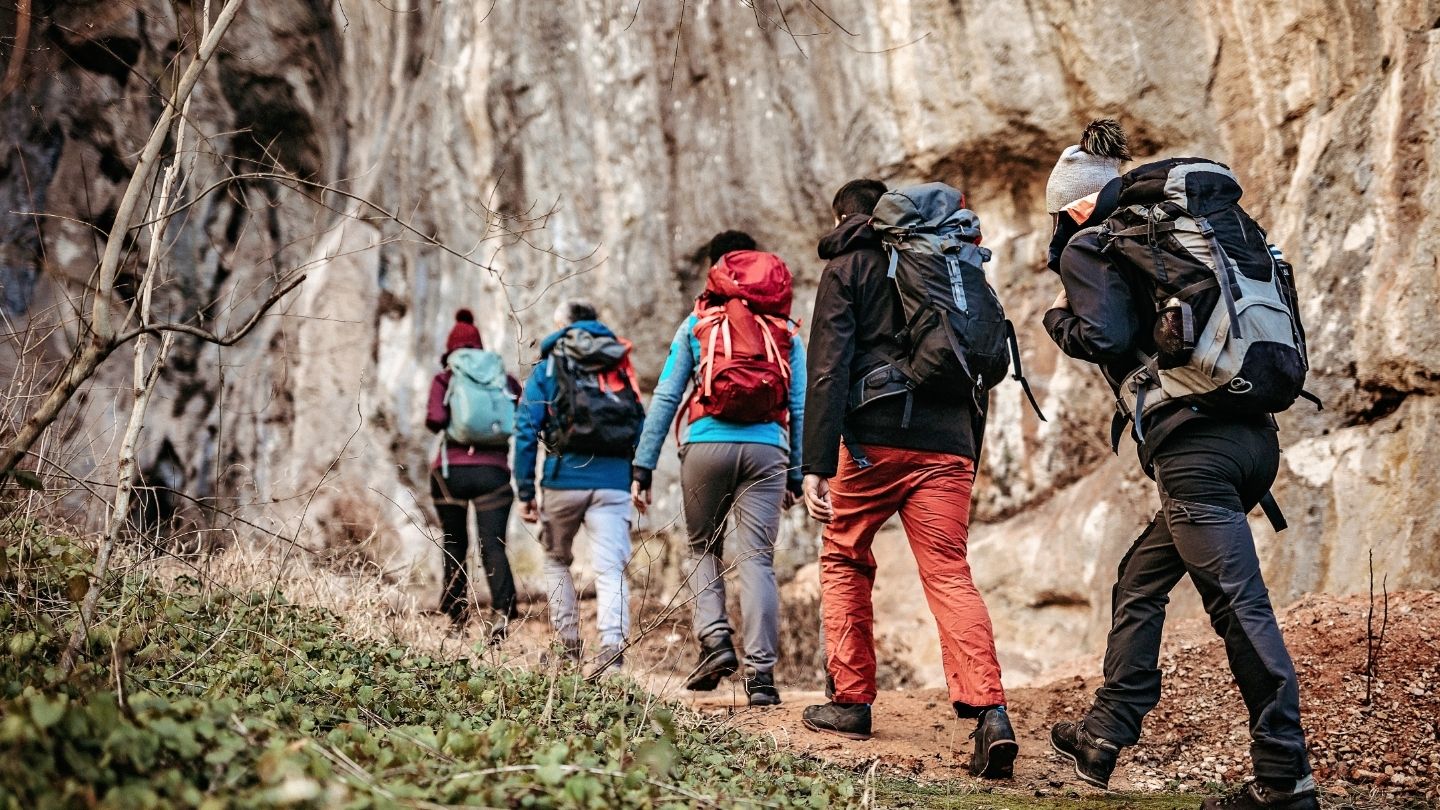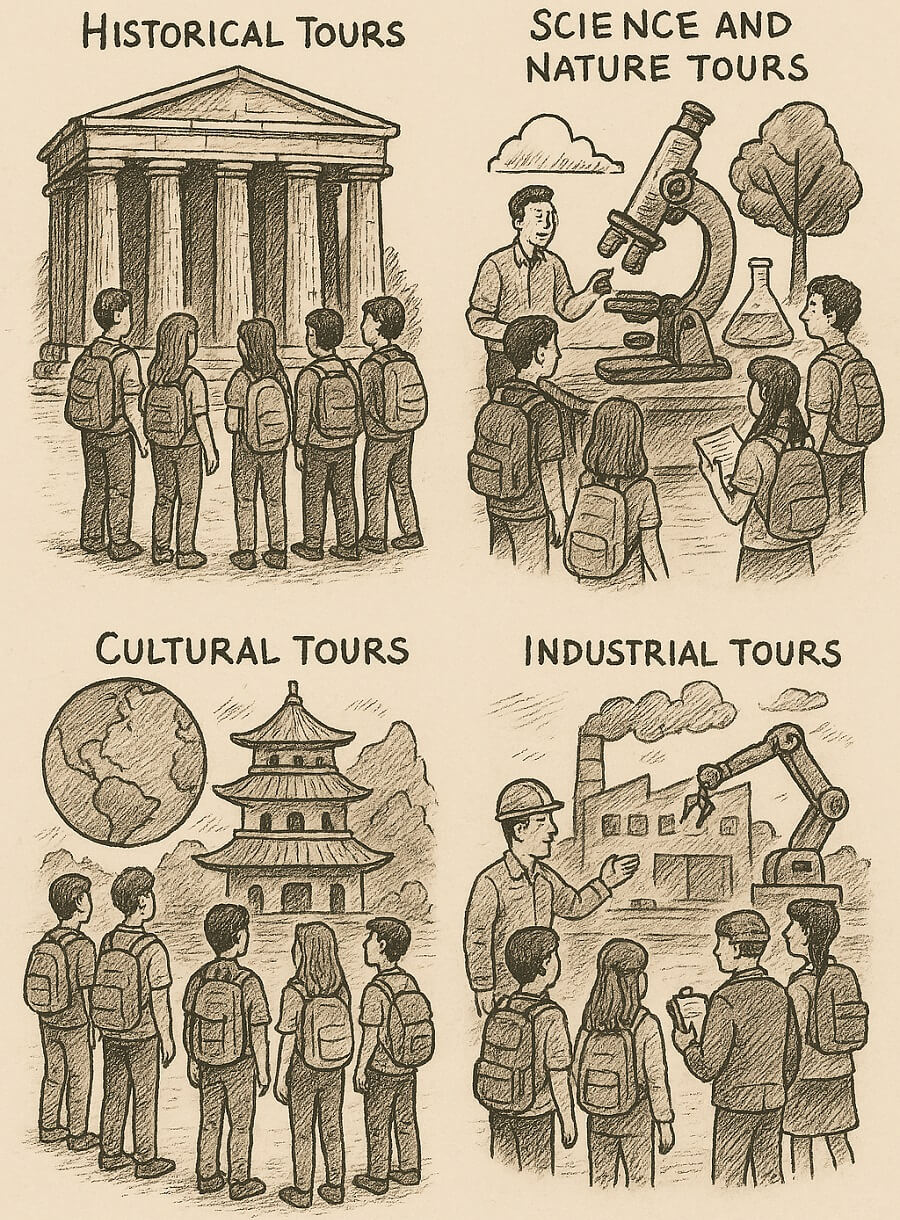
How Educational Tours Improve Classroom Learning
Educational tours—museum visits, science center days, heritage walks, factory tours, wetlands sampling, and court observations—turn classroom lessons into real-world experiences.
When teachers set clear goals, give a short orientation, guide inquiry during the visit, and follow up with reflection, students gain deeper knowledge, improve critical thinking, and show more interest in learning.
Multi-visit programs across the year link to higher grades, fewer absences, and better behavior. These benefits are strongest when schools reduce cost barriers and plan for inclusion.
Table of Content
- How Educational Tours Improve Classroom Learning
- What Counts as an Educational Tour
- Why Tours Work: Two Practical Frameworks
- The Evidence: What Strong Studies Report
- Design Blueprint: Turn a Day Out into Real Learning
- Teacher Roles That Matter
- Place-Based Education: Using the Community as Curriculum
- Outdoor and Adventure Learning
- Barriers and Practical Fixes
- Assessing Learning from Tours
- Digital and Virtual Tours
- Safety and Risk Management
- Equity and Inclusion
- Questioning Skills That Make a Tour Work
- Three Ready-to-Use Blueprints
- Case Notes from Practice
- Key Takeaways
- Conclusion
- FAQs

What Counts as an Educational Tour
Educational tours are structured, purposeful visits to real settings that connect directly to what students are studying. Examples include:
-
Museums, archives, and heritage sites
-
Courts, municipal offices, and parliaments
-
Factories, farms, and research labs
-
Rivers, forests, and conservation areas
-
Neighborhood walks, clinics, or community centers
A visit is truly educational when it includes clear goals, a short pre-visit orientation, structured inquiry on site, and a reflective task after the visit.
Why Tours Work: Two Practical Frameworks
Kolb’s Cycle in Plain Terms
-
Concrete experience: Students see, touch, and interact with real places and objects.
-
Reflective observation: They notice patterns and surprising details.
-
Abstract thinking: They connect the experience to models and theories.
-
Active experimentation: They test or create something new based on what they learned.
Trips planned around these four steps are consistently more effective.
Contextual Model of Learning
Learning is shaped by three contexts working together:
-
Personal: what students already know and care about
-
Sociocultural: peers, teachers, and guides who shape discussion
-
Physical: the design of the site and objects encountered
Planning across before–during–after phases helps students learn in all three contexts.
The Evidence: What Strong Studies Report
Cognitive and Academic Outcomes
-
Museum tours improve factual knowledge, analysis, and historical empathy.
-
Multiple trips within a year raise test scores, improve grades, and reduce absences.
-
Science-focused visits deepen understanding of core ideas and reasoning when linked to classroom learning.
Motivation, Identity, and Social–Emotional Growth
-
Students report more curiosity and confidence after visits.
-
Outdoor programs build teamwork skills and resilience, especially longer residential programs.
-
Field trips can expand students’ cultural horizons and willingness to engage with new ideas.
Equity Effects
Students from low-income families often benefit the most but face cost and transport barriers. Schools that plan fee waivers, sponsor support, and transport solutions see better participation.
Long-Term Retention
Students remember what they saw and heard for years when visits are tied to classroom lessons. A short pre-visit orientation helps students learn more once they arrive.
Design Blueprint: Turn a Day Out into Real Learning
Pre-Visit (45–60 minutes)
-
Define clear outcomes: two or three content targets and one skill focus.
-
Prime background knowledge with images or short texts.
-
Assign student roles: recorder, questioner, sketcher, timekeeper.
-
Coordinate with the site on timing, stations, and accessibility.
-
Prepare logistics: safety plan, parent letters, and cost support.
During the Visit
-
Provide choice boards so students select tasks like sketching, comparing, or interviewing.
-
Use quick teacher prompts: “What makes you think that?” or “Where do you see evidence?”
-
Include two micro-huddles to review findings and connect to goals.
-
Capture photos, notes, or measurements for post-visit work.
Post-Visit (Within 48 Hours)
-
Hold a reflection session: What happened? What does it mean? What can we do with it?
-
Assign a performance task such as writing a curator label, creating a data-based recommendation, or preparing a short class presentation.
-
Use rubrics that assess evidence, reasoning, and clarity.
-
Extend learning by inviting a site educator for a Q&A or displaying student work publicly.
Teacher Roles That Matter
Teachers should act as learning coaches, not only chaperones. Active questioning and connecting site observations to prior lessons help students gain more from the visit.
Place-Based Education: Using the Community as Curriculum
Local rivers, markets, clinics, libraries, and town councils can be part of curriculum units. Students gain relevance, produce more detailed writing, and see how lessons connect to their own community.
Outdoor and Adventure Learning
Multi-day programs build teamwork and confidence. Keep reflection sessions, student leadership roles, and links back to coursework for stronger outcomes.
Barriers and Practical Fixes
Cost and Transport
-
Plan trips early in the year and spread payments.
-
Use fee waivers and reduced admission days.
-
Partner with local sponsors to cover transport.
-
Offer private payment options to protect student dignity.
Time and Paperwork
-
Keep a reusable risk-assessment template and standard parent letter.
-
Combine subjects when planning longer trips to limit time away from class.
Curriculum Pressure
-
Map visit tasks to standards and replace a classroom assessment with a post-visit project.
Assessing Learning from Tours
Concept Maps
Students draw a map before and after the trip to reveal growth in understanding.
Performance Tasks
Short written pieces such as curator labels or data-backed briefs show what students have learned and how they apply it.
Social–Emotional Rubrics
Assess collaboration and curiosity during the visit to capture growth beyond academic outcomes.
Digital and Virtual Tours
Virtual tours work well for previews or follow-up discussions. They are most effective when students produce something, such as a narrated comparison or a short analysis.
Safety and Risk Management
Prepare routes, ratios, emergency contacts, and medical information. Use buddy systems, clear meeting points, and parent communication that explains the purpose and schedule.
Equity and Inclusion
Translate parent letters, invite multilingual chaperones, and select sites that reflect diverse cultures. Stock shared gear so no student is left out.
Questioning Skills That Make a Tour Work
Teacher Talk Moves
-
“What makes you think that?”
-
“Where do you see evidence?”
-
“Who has a different view?”
-
“How does this connect to our question?”
Observation Prompts
-
“Sketch two features and label them.”
-
“Compare two sources with different perspectives.”
-
“What variable would change the outcome?”
-
“What problem was this object meant to solve?”
Three Ready-to-Use Blueprints
Primary: Local History Museum
-
Pre-visit picture walk and two driving questions
-
Choice tasks during visit and mid-point huddle
-
Post-visit curator label and peer review
Lower Secondary: Wetland Ecology
-
Pre-visit mini-lesson and data sheet practice
-
Three on-site stations: water quality, biodiversity, human impact
-
Post-visit evidence-based essay using student data
Upper Secondary: Factory Tour
-
Pre-visit process flow chart and assigned roles
-
On-site observation of inputs, outputs, and worker tasks
-
Post-visit report comparing process to textbook model with improvement proposal
Case Notes from Practice
Wetland Visit Example
Grade 7 students tested water quality, counted species, and mapped a storm drain outfall. Their post-visit essays used data, numbers, and place names, showing stronger evidence use.
Museum Label Example
Grade 4 students wrote labels for two artifacts showing different sides of a local story. Parents visited the hallway exhibit, turning the task into a community learning moment.
Key Takeaways
-
Combine pre-visit, on-site, and post-visit activities for deeper learning.
-
Plan multiple trips per year for stronger long-term effects.
-
Address cost barriers early to keep trips inclusive.
-
Link outdoor and community visits to coursework and reflection.
-
Use questioning skills and student choice to keep tours engaging.
Conclusion
Educational tours bring lessons to life. With a short orientation, clear on-site tasks, and a reflective product afterward, a single visit can anchor weeks of learning. Build trips into the school year plan, mix short local visits with larger ones, and make inclusion a priority. The result is knowledge that lasts, stronger reasoning skills, and students who see themselves as capable learners in their communities.
FAQs
1) How many trips should a school plan each year?
Two to four trips spread across the year are manageable and effective.
2) What if budgets are limited?
Choose nearby low-cost sites, request fee waivers, and partner with community sponsors for transport.
3) How can teachers show that learning happened?
Use post-visit performance tasks and concept maps to capture evidence of learning.
4) Can virtual tours replace physical visits?
They are useful as previews or follow-ups but should not replace real visits entirely.
5) How do we prepare students for unfamiliar settings?
Give a short site overview, review key terms, and outline roles and tasks before the visit.



